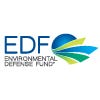Tracking the connections between air pollution and COVID-19
By Elena Craft, Senior Director, Climate and Health, Environmental Defense Fund
We often hear that COVID-19 does not discriminate, but it is clear the virus is killing black people at higher rates than any other group. In Houston, for example, they account for 38 percent of the deaths but 22 percent of the city’s population.
Why is this happening?
Even without the pressing threat of coronavirus, those living near Houston’s oil refineries, petrochemical plants, concrete batch plants, and freeways are mostly people of color and low wealth.
They are the ones hit first and worst by air pollution but most likely to lack access to health care. It is a one-two punch of greater risks and fewer resources.
Scientists, like me, are just beginning to understand the relationship between COVID-19 and air pollution. One preliminary analysis shows that areas with elevated air pollution levels before the pandemic had higher COVID-19 death rates — but more data is critical, given the lack of testing and paucity of information about the virus.
Data is essential to rebuilding healthier communities
I work at Environmental Defense Fund, and to gain insights, we are collaborating with Rice University, the Gulf Coast Center for Precision Environmental Health and several public health departments in the Houston region on the COVID-19 Registry.
We designed this effort to help public officials understand why some people are more at risk, what they can do about it and how they can rebuild better to address underlying disparities in our public health.
The COVID-19 Registry, for example, will help:
· Track virus spread over time and across geography.
· Measure economic and health impacts.
· Anticipate healthcare needs as the pandemic unfolds.
· Understand behavior in response to policy changes.
· Identify popular and effective sources of information.
Deploying resources where they’re needed most
We know data and knowledge can save lives. Government at all levels can use the real-time information from the COVID-19 Registry to deploy resources to those with the most need. And decision-makers can rely on it to chart a fair and just recovery that protects the health and well-being of everyone.
In Houston, that might mean deploying more air quality monitors and more pollution controls in areas with high levels of soot — the tiny airborne particles that contribute to heart and lung diseases and many other underlying conditions that are making COVID-19 more deadly.
Building a registry to learn from crisis
The COVID-19 Registry uses the same survey and data-analysis tools that our partners developed for the Texas Flood Registry, which launched in early 2018 to quantify Hurricane Harvey’s toll on people’s physical and mental health. Since then we have expanded that registry to collect information on other catastrophic flooding events and have made data available to researchers and public officials through Rice’s Urban Data Platform.
Nearly 30,000 people are participating voluntarily in The Texas Flood Registry, mostly through community outreach.
We are in position to build a larger cohort with the COVID-19 Registry because of partnerships with the Gulf Coast Center for Precision Environmental Health (GC-CPEH) at the Baylor College of Medicine and the University of Texas Medical Branch. The Houston-based institutions provide the registry questions to people receiving COVID-19 tests.
The survey asks people about their physical and mental health — and whether they have experienced symptoms of COVID-19. It also includes questions about personal behaviors, work or employment status, and home life due to the pandemic. This information will help public health professionals gain insights on the health and economic impacts of behavior changes and social distancing orders.
The registry also prompts participants to provide updates every two weeks. Mental health is a significant concern because of isolation from staying home and anxiety over contracting a COVID-19 infection.
Still too little testing
Early data shows far more people are experiencing COVID-19 symptoms than are receiving tests.
Only 10% of those who had a fever or felt feverish received tests, and 13% of those who recently had developed shortness of breath were tested.
More than 90% of respondents say they have changed behaviors, like washing their hands more often and avoiding crowds. Meanwhile, nearly 30% say they feel nervous or anxious more than half the time.
So far, the vast majority of registry participants are in the Houston area. We plan to expand the registry nationally.
It is essential that we work with the communities most impacted by this crisis and rebuild a better world where the air is cleaner, communities are healthier, and opportunities for everyone are greater.
